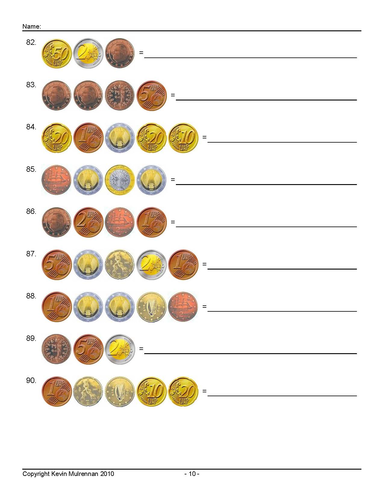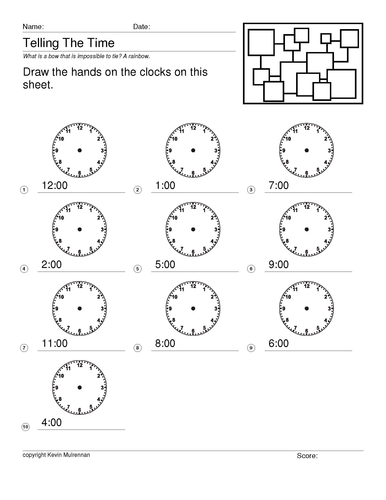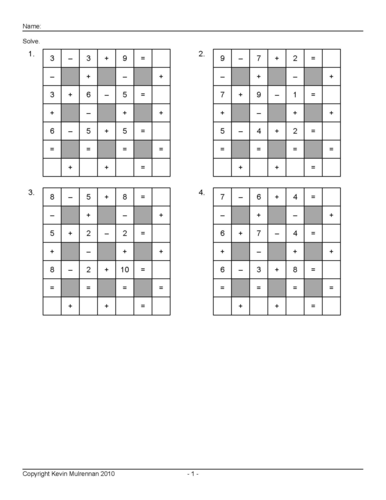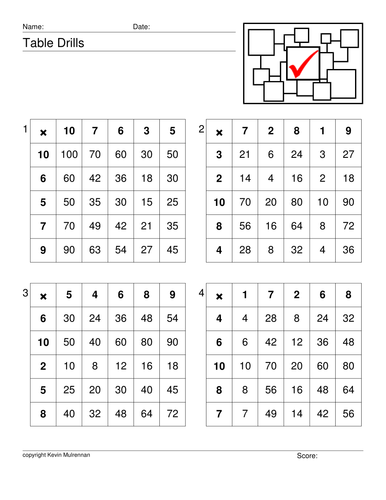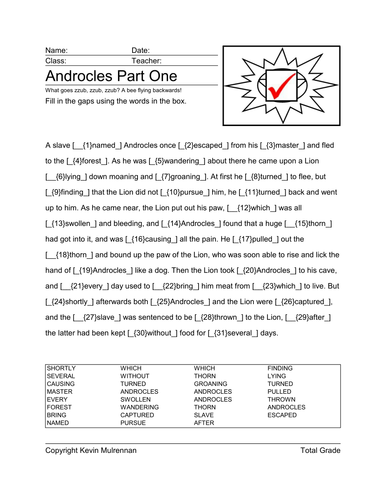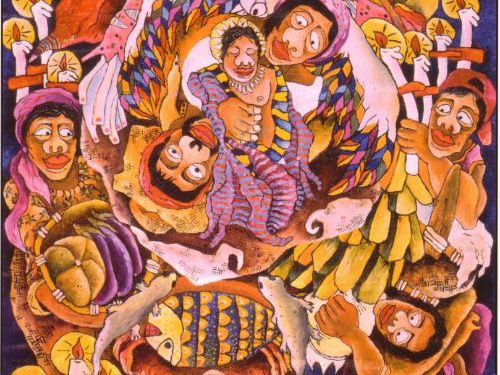358Uploads
98k+Views
29k+Downloads
All resources

Freebie Free 5 Worksheets Maths Shopping Arithmetic KS1 KS2 Money Counting
A freebie.
If you like these I have 100 for sale in my shop.
I have designed 5 worksheets on Money and Shopping for primary school children. I have used a variety of items, a variety of difficulty and a variety of numbers of questions per sheet. Pupils write on the sheets the total cost. e.g. a milkshake costs £2.90 a hot dog £1.65 How much would 2 milkshakes and 3 hotdogs cost? There is plenty there to reinforce the work done in the classroom. Good for extra homework or additional work for the bright ones. Answer sheets are provided for all worksheets.

Freebie Telling Time KS1 KS2 Mathematics Clocks Minutes Hours
A sheet where pupils have to put the correct times in.
If you like this, please visit my shop where you can buy a full set.

Freebie 2 French Wordsearches KS1 KS2 Perfect for Friday Afternoons With Answers
2 French wordseaches with answers.
Each one has 20 basic words to find.
Perfect for rainy Friday afternoons, homeworks etc.
If you like these, please visit my shop where you can purchase 500 of these at a very reasonable price.

Euro Coins Worksheets KS1 KS2 Mathematics Freebie
A worksheet that pupils have to fill in. They have to add up the coins.
If you like it, please visit my shop that has an enhanced similar product.

Freebie Fractions KS1 KS2 Mathematics Simplifying Mixed Fractions etc
An example freebie of my self-designed fractions sheets.
If you like this one, please take a look at my shop.
You could but half a million questions on fractions.
Or maybe ones on simplifying fractions, Mixed fractions etc.
Please look for the bundles if you are looking for great value.

Freebie Telling the Time KS1 KS2 Mathematics
A sheet with answers where pupils have to draw the hands to show the time on a small clock.
If you like this, please visit my shop where there is a more sophisticated product.

Maths Puzzle Across Down Addition and Subtraction Puzzle Plus Answers
Great for reinforcing maths.
Across-Downs is a fun activity that reinforces addition and subtraction skills.
The object of the exercise set is to find the answer for each row and column, then use those answers to calculate the final answer in the lower right-hand corner of the puzzle.
This tests addition and subtraction.
If you like this freebie, please visit my shop which has loads of puzzles for sale. Buy the bundles for best value.

Table Drills Mathematics Multiplication KS1 KS2 Maths Freebie Free
If you like this resource more available in my shop.
Fill in the gaps to get the correct multiplication answer.

Aesop Fable Cloze Test Androcles Classics Latin
A cloze test on an Aesop fable.
If you like this one I have a collection in my shop.
You get many, many more of them at a reasonable price.
Great timefiller for Froday afternoons or homework.
If you like the product, please leave a good review, especially as it’s FREE! Thank you!

Latin Word Search Freebie plus answers Cambridge Latin Course
A freebie.
A Latin word search.
If you like this one, I have 500 for sale in my shop.

Free Freebie Good Samaritan Lesson Simple and Effective for Year 4 R.E. Literacy
Got me a job so must be reasonable!
A simple lesson plan, worksheet, powerpoint.
Great for discusiing with pupils.
I have plenty of maths, literacy, languages and Literacy stuff so have a look after downloading this freebie.

Christmas Powerpoint Free Freebie Lesson Taster Advent Religious Studies
A freebie.
A nice powerpoint on the religious aspect of Christmas.
I’m hoping to interest you in buying my series of Christmas lesson on R.E.

Literacy Ideas Talk For Writing Wolves Emily Gavett
Nice powerpoint and notebook files and great grammar word document that you can use for display.

Romeo and Juliet Shakespeare Rewrite Year 6 English Literacy Planning
Couple of weeks planning.
sample;
Genre: Narrative Unit 4 ‘Older Literature’
Focus Texts: ‘Romeo and Juliet’ by William Shakespeare. (Adapted for children by Andrew Matthews and Tony Ross – Orchard classics).
Begin by introducing the new topic and the learning outcome. We will be studying ‘older’ literature. Explain that older literature is defined as anything written before 1914 but we are going to look at much older than this!
Show a picture of William Shakespeare: children to TTYP –
Who is this man?
What is he famous for?
Can you name any of his works?
Come back together and elicit that William Shakespeare was an author – not of stories but of plays and sonnets (poems). Talk about some of his more famous work and explain that he wrote 38 plays and over 160 sonnets.
Shakespeare was born in 1564 and died in 1616. He produced most of his work between 1589 and 1613 – why do you think he wrote mostly plays rather than stories? Elicit that he was an actor so he loved the stage and he intended his works to be acted out rather than just read and also because of the times. TV and film were not entertainment options and the majority of people couldn’t read so going to the theatre or watching an outside performance was very popular.
Explain that Shakespeare’s plays can be broadly split into tragedies and comedies. TTYP – what does this mean?
Show a list including some of Shakespeare’s most famous comedies and tragedies.
Talk about our recent history topic – who would have been on the throne when Shakespeare was writing (Elizabeth I until 1603 and then James I start of the Stuart dynasty). Talk briefly about the context to Shakespeare’s plays – Elizabeth I ruled over a very successful empire, England was starting to explore and find new shores and arts & culture were becoming more important and sought after. Link to previous unit.
Children to take a whole page in their literacy books to design an advert/poster to be put up around a Tudor town. It should advertise an exciting new play by William Shakespeare (give children a few to choose from).
Talk about the different language used for a comedy or a tragedy.
CN with target group.
CS with JD group. Start to read the children’s adapted version of ‘Romeo and Juliet’.
Success Criteria:
I recognise William Shakespeare and I know what he did for a living.
I can start to understand what England was like when Shakespeare was writing.

Matilda Road Dahl Literacy Lesson Year 6 plus types of noun powerpoint
nice easy lesson.
sample:
TTYP – why do authors use descriptive vocabulary? Take feedback and jot down ideas for the working wall – elicit the idea that, as a writer, it is our job to create an image in the reader’s mind.
Show the part of ‘Matilda’ where the main character approaches Crunchem Hall for the first time. 22 min 30 to 24 min 30.
Take part in ‘Book Talk’ on this visual text:
How did we feel about Matilda when we watched her walk into the school under the arch?
How did we feel about the school buildings and environment?
What impressions have we made about Miss Trunchbull?
How were we made to feel like that?
How did the director manipulate our emotions?
Show the ‘Likes, dislikes, patterns and puzzles’ board and explain the task .
Task 1 11am-11.10am
Engaging with the visual text.
A – Australia group (Level 3a/4c): Children to fill in an individual ‘like/dislikes’ board. Children to focus particularly on the ‘patterns and puzzles’ sections. Working independently. Extension task – children to annotate a still from the film with adjectives to describe the setting.
BA – Brazil group (Level 3b/c): Miss Greenwood to support and extend. Children to fill in an individual ‘like/dislikes’ board.
SEN/BA – Mexico group (Level 2): Working with Miss Noble on a guided like/dislikes board. Extending children to talking about the atmosphere.
Main Teaching 2 10 minutes (11.10am – 11.20am)
Share some ideas from the task and explain that now we are fully immersed in the text, we are going to start to transfer the clip into a written text.
TTYP – what does ‘atmosphere’ mean? Talk and agree that it means: a feeling or mood created by a particular place. I am going to attempt to describe the setting AND the atmosphere to the reader. I am going to write in third person and past tense.
Elicit the use of the senses for a setting description.
Model write with reference to s/c and sentence trick cards.

Year 3 Literacy Planning The Hodgeheg by Dick King Smith
Planning for this interesting book.
sample
Show chn the front cover of The Hodgeheg and say that we will be working on this book. Read blurb on back then ask chn what type of story they think this is? Establish that it is a Quest or Adventure story with a problem, journey and resolution. Ask chn what else the blurb tells us and note their ideas for Working Display notes. (E.g. the main character is Max who is a hedgehog, he has a family and he wants to cross the road…). Explain that today we are going to be Sentence Detectives as we read the story. We are looking for sentences which have adverbs in them. Revise the fact that an adverb modifies a verb, telling us how something was done: She went happily to see her granny. Develop this to talk about fronted adverbials, phrases at the start of a sentence which act like an adverb, telling us how, where or when something is done or happened, e.g. In total silence, the girls tiptoed along the corridor. Comprehension 1/ Grammar 1 Display extract from Hodgeheg (see resources). Read it out loud together. Briefly revise the rules for writing dialogue: (1) Speech marks around direct speech; (2) new speaker = new line;
(3) Punctuation (question marks, exclamation marks, commas, full stops) that goes within the speech marks.
Point out that if the dialogue finishes but it’s not the end of a sentence, then a comma goes at the end of the dialogue within the speech marks. See resources for marked up example. Then make-up physical signs for each type of punctuation, e.g. speech marks = hands held up, 2 fingers on each hand bent; comma = one finger drawing it in the air; full stop = pointing gesture, etc. Draw a map of the passage together, (look at the example map resource to guide you). Ask chn for suggestions for each element. Spoken language 1

Year 5 Literacy Persuasion Lesson Persuasive Writing
Great little lesson or short set of lessons for persuasive writing. Couple of nice powerpoints.
Endangered Pandas
Pandas are rare today and are protected by law in China. In 1963, the first panda was exhibited in a zoo outside of China. Today, there are more than a dozen pandas in most zoos. Pandas can be seen in zoos in Washington D.C, Mexico City, London, Tokyo, Madrid, Paris, and Berlin. All pandas in zoos are given double names; this is a Chinese custom, which indicates affection. Scientists study the zoo pandas in hope to learn how to save wild pandas from extinction. There are only about 700 to 1000 pandas alive in the world today.
Imagine you are one of the scientists that are researching pandas and a philanthropist has come to you and offered you a substantial research grant if you can persuade him that your research deserves. He asks you, “What makes a Panda so special that it should be saved?”…. your response is crucial!!!
In both short and extended texts, I can use appropriate punctuation, vary my sentence structures and divide my work into paragraphs in a way that makes sense to my reader.
Tools
LIT 2-22a
Throughout the writing process, I can check that my writing makes sense and meets its purpose.
Tools
LIT 2-23a
I am learning to use language and style in a way which engages and / or influences my reader.
Creating Texts
ENG 2-27a
Learning Intention ~ I can use personal research to create a persuasive piece of writing.
Success Criteria – have you… (Tick as you have achieved) ???
I have used emotive and descriptive language to engage the reader’s emotion
I have punctuated accurately
I have used paragraphs effectively to organise my ideas
I have proof read and self-corrected using a variety of resources

Back to school year 5 Literacy Design a Chocolate bar Month's worth planning
A great month of planning.
lots of powerpoints.
Pupils have to use persuasive language to make a chocolate bar.
sample
Adverts will be up on the board. Introduce topic by asking what it is… (5mins)Asked to identify the aim of the advert (using mini whiteboards). Teacher leads discussion through the answers e.g. “what made you think it was that purpose?” (10mins)
Then asked to go to tables and work in mixed ability groups to identify the aims of adverts on their tables – recording this info(15mins). Extension work – to write the features as to how they knew it was that purpose.
class discussion as to the aims of the adverts – questioning how they know that(5mins)etc
Discussion to lead onto ‘who is the intended audience’, again using mini whiteboards at first(5mins), then back to groups to identify the audience of the adverts they had seen before – recording this information(10mins).
Discuss the audience – recap with new adverts asking pupils to identify both purpose and audience as plenary. (10mins)
Starter – to recap on purpose and audience of adverts quickly on the board, using adverts seen yesterday then new advertisements that weren’t seen yesterday (5mins).
Put cadburys cream egg advert on board and ask the children to point out some of its features. Ask questions like ‘what makes this advert stand out’ talk about the colour, the slogan, the brand, the image. Put up some other advertisements and ask them to point out the slogan, talk about how slogans rhyme, have a play on words, are short, use alliteration etc (10mins).
Go back to their tables where there will be some recognisable products (coca-cola, mars bar, bouncy ball, yazoo milkshake), where children have to come up with a slogan for each. Extension work – come up with more than one slogan and they have to pick their favourite. (15mins)
Children then share their slogans with the rest of the class. Table points for the best.
Point out that slogans are in big bold fonts and match the phrase e.g. the Cadbury one is ‘gooey’,
Children draw out their favourite slogan on A4 paper – to colour in too (20mins).
Children asked to explain why they used certain colours or style of writing for their slogans for that product. (5mins).
Homework – find 5 slogans from ads.

Year 4 English Maths planning kr Short and Medium
Collected together my year 4 lesson planning from outstanding academy.
Mainly English and Maths.
sample:
Tuesday 31.01.12
LO: To understand how the use of expressive and descriptive language can create effects or generate emotional responses.
Read a descriptive/emotive poem ( Poems Not To Missed)
JBA & JP to model how to express how the poem made us feel and what impact the vocabulary choices had on us and why?
Read two poems that are expressive and descriptive.
Ask chn What was your immediate reaction? Which vocabulary choices were effective and had impact? Why? What emotions do you get from the poems? What images did you get from the poems?
Wednesday 01.02.12LO: To plan an ICT-based poetry presentation that involves each member of the group
Recap leaning - What are they learning? What have they learnt about poetry texts? Why is learning about poetry important? How could you use what you have learnt about performing poetry?
Inform chn that they are going to plan a poetry presentation. Discuss What is a poetry presentation? What is the purpose of a poetry presentation? How are poetry presentation put together?
Explain that they are going to promote a poem using key language/emotions from the poem.
In talk partners discuss what makes ‘good’ poetry? JP/JBA to scribe chn ideas on ‘working wall’
Using visual Literacy watch clips from poetry readings that the chn have watched previously. Ask:
What makes the poem a ‘good’ poem and why? Can you identify key language/emotions/rhythm in the poem that would entice others to read the poem and why? How would you go about putting the key language/emotions together to create a poetry presentation? JP/JBA to scribe chn ideas on ‘working wall’
JBA & JP model how we plan to put together a poetry presentation for a poem we have read. Explain that a presentation is to demonstrate the understanding of a poems’ key message.
Show what we are thinking when planning a poetry presentation. Which parts of the poems’ language was effective? What was the most emotional verses and why? Which verse has rhythm? How could we present this poem through drama? Thought shower ideas on working wall.

year 1 Literacy Fantasy World Planning
Three great powerpoints.
Two great flipcharts.
Planning.
Sample:
Discuss fantasy settings we know so far as a whole class using Fantasy PP 1.
Reinforce the concept of a fantasy setting by showing lion, witch and wardrobe where child walks into Narnia clip:
http://www.youtube.com/watch?v=JMYU5vSaal8
In talking partners discuss adjectives describe the setting. Beach ball/Bean bag ideas.
Feedback to group.
Recap yesterday’s learning. Then use the Fantasy PP 2 and go through with the children how to create their own fantasy world.
Explain the activity – children to create on paper their own fantasy world and label it.
Must include:
Setting
Characters
Magical objects
Watch the clip from Harry Potter in the magic shop and encourage the children to look out for all the magic objects: http://www.youtube.com/watch?v=hDR5XgHHLBY and http://www.youtube.com/watch?v=szEFdhOHtrI (0-40 seconds)
Make a list of all the objects they could see, what they could be for, using Fantasy PP 3.
Explain the activity; children will be creating a magic object from their setting they created yesterday or a new one. What does it look like? What is it called? Etc




